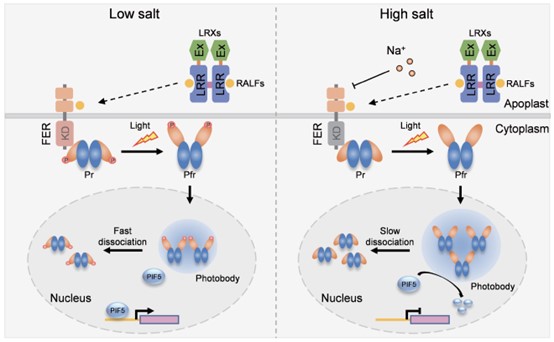Abstract: Salt stress is a major environmental stress that threats crop growth and yield. It is of great significance to study the molecular genetic network of plants in response to salt stress. In a study published in Nature Plants, Dr. Zhao's group uncovers a novel mechanism underlying the coordination of plant growth and salt tolerance in plants.
Salt stress is a major environmental stress that threats crop growth and yield. Therefore, it is of great significance to study the molecular regulatory network of salt tolerance in plants and to cultivate crops with enhanced salt tolerance. A major challenge for plants to adapt to salt stress is to coordinate growth and stress response, but currently the molecular mechanisms underlying the regulation of the balance between growth and salt stress response are still largely unknown.
In a study published in Nature Plants on Apr. 3, Dr. ZHAO's group from CAS Center for Excellence in Molecular Plant Sciences, Chinese Academy of Sciences, uncovers a novel mechanism of how plants coordinate plant growth and salt tolerance.
Dr. ZHAO's group mainly focuses on studying the genetic network of salt stress response in plants. In previous studies, this group found that leucine-rich repeat extensins (LRXs) and FERONIA (FER) function as a module to regulate plant growth and salt tolerance, but how this module regulates the balance between plant growth and salt stress response remains unknown.
In this study, the researchers report that phytochrome B (phyB) mutation suppresses both the dwarfism and salt-triggered leaf bleaching of the lrx345 and fer-4 mutants. Further studies show that FER directly phosphorylates phyB and the phosphorylation modification is required for modulating the dark reversion rate and the accumulation of phyB protein in the nucleus. Salt stress attenuates phyB phosphorylation by inhibiting FER kinase activity, which results in a slower phyB dark reversion rate and increased accumulation of phyB in the nucleus.
“Our data show that tight control of phyB protein abundance in the nucleus is critical for balancing growth and stress response, which is finally beneficial for plant survival under high salinity,” ZHAO said.
In rice, OsphyB mutation significantly enhances salt tolerance, indicating that phyB gene is a potential genetic loci to improve salt tolerance in crops.
“This study reveals a key kinase that phosphorylates phyB, and elucidates the important biological significance of phyB phosphorylation in plant salt stress response.” ZHAO said. “This study also reveals a novel molecular mechanism of how plants coordinate growth and salt stress response, and provides a theoretical basis for breeding salt-tolerant crops.”
